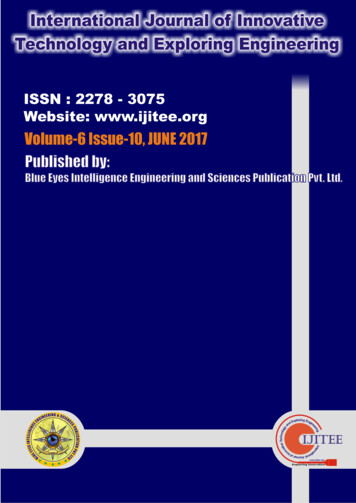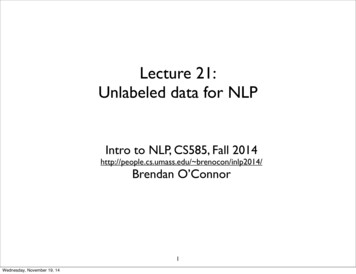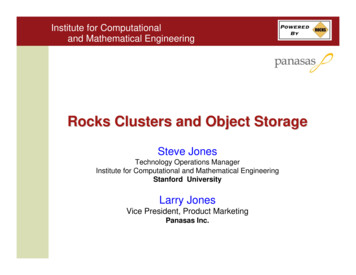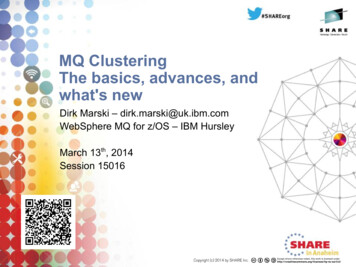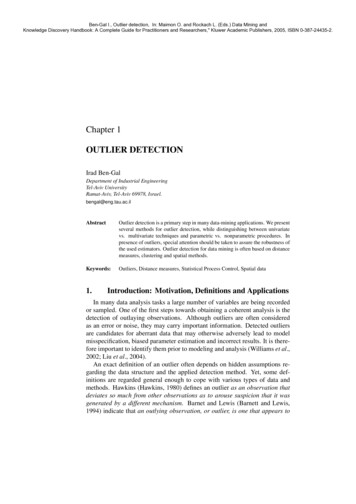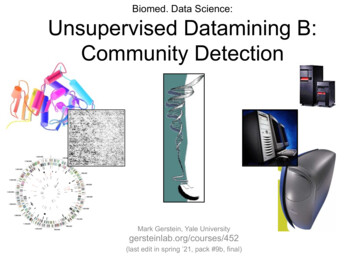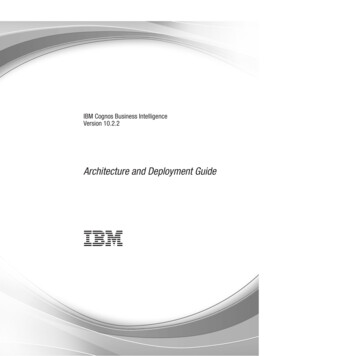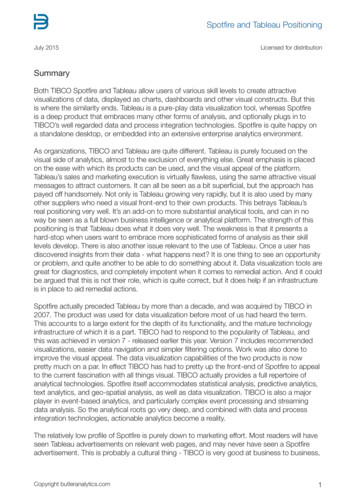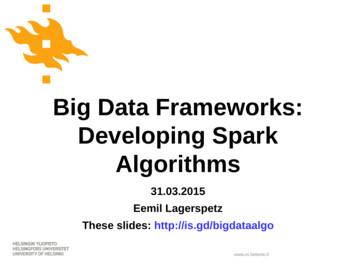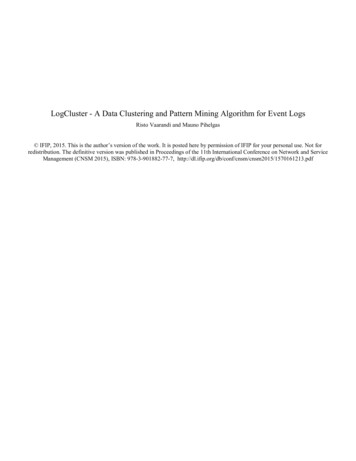
Transcription
LogCluster - A Data Clustering and Pattern Mining Algorithm for Event LogsRisto Vaarandi and Mauno Pihelgas IFIP, 2015. This is the author’s version of the work. It is posted here by permission of IFIP for your personal use. Not forredistribution. The definitive version was published in Proceedings of the 11th International Conference on Network and ServiceManagement (CNSM 2015), ISBN: 978-3-901882-77-7, 3.pdf
LogCluster - A Data Clustering and Pattern MiningAlgorithm for Event LogsRisto Vaarandi and Mauno PihelgasTUT Centre for Digital Forensics and Cyber SecurityTallinn University of TechnologyTallinn, Estoniafirstname.lastname@ttu.eeAbstract—Modern IT systems often produce large volumes ofevent logs, and event pattern discovery is an important logmanagement task. For this purpose, data mining methods havebeen suggested in many previous works. In this paper, we presentthe LogCluster algorithm which implements data clustering andline pattern mining for textual event logs. The paper alsodescribes an open source implementation of LogCluster.Keywords—event log analysis; mining patterns from event logs;event log clustering; data clustering; data miningI.INTRODUCTIONDuring the last decade, data centers and computer networkshave grown significantly in processing power, size, andcomplexity. As a result, organizations commonly have tohandle many gigabytes of log data on a daily basis. Forexample, in our recent paper we have described a security logmanagement system which receives nearly 100 million eventseach day [1]. In order to ease the management of log data,many research papers have suggested the use of data miningmethods for discovering event patterns from event logs [2–20].This knowledge can be employed for many different purposeslike the development of event correlation rules [12–16],detection of system faults and network anomalies [6–9, 19],visualization of relevant event patterns [17, 18], identificationand reporting of network traffic patterns [4, 20], and automatedbuilding of IDS alarm classifiers [5].In order to analyze large amounts of textual log datawithout well-defined structure, several data mining methodshave been proposed in the past which focus on the detection ofline patterns from textual event logs. Suggested algorithmshave been mostly based on data clustering approaches [2, 6, 7,8, 10, 11]. The algorithms assume that each event is describedby a single line in the event log, and each line patternrepresents a group of similar events.In this paper, we propose a novel data clustering algorithmcalled LogCluster which discovers both frequently occurringline patterns and outlier events from textual event logs. Theremainder of this paper is organized as follows – section IIprovides an overview of related work, section III presents theLogCluster algorithm, section IV describes the LogClusterprototype implementation and experiments for evaluating itsperformance, and section V concludes the paper.This work has been supported by Estonian IT Academy (StudyITin.ee)and SEB Estonia.978-3-901882-77-7 2015 IFIPII.RELATED WORKOne of the earliest event log clustering algorithms is SLCTthat is designed for mining line patterns and outlier events fromtextual event logs [2]. During the clustering process, SLCTassigns event log lines that fit the same pattern (e.g., Interface* down) to the same cluster, and all detected clusters arereported to the user as line patterns. For finding clusters in logdata, the user has to supply the support threshold value s toSLCT which defines the minimum number of lines in eachcluster. SLCT begins the clustering with a pass over the inputdata set, in order to identify frequent words which occur atleast in s lines (word delimiter is customizable and defaults towhitespace). Also, each word is considered with its position inthe line. For example, if s 2 and the data set contains the linesInterface eth0 downInterface eth1 downInterface eth2 upthen words (Interface,1) and (down,3) occur in three andtwo lines, respectively, and are thus identified as frequentwords. SLCT will then make another pass over the data set andcreate cluster candidates. When a line is processed during thedata pass, all frequent words from the line are joined into a setwhich will act as a candidate for this line. After the data pass,candidates generated for at least s lines are reported as clusterstogether with their supports (occurrence times). Outliers areidentified during an optional data pass and written to a userspecified file. For example, if s 2 then two cluster candidates{(Interface,1), (down,3)} and {(Interface,1)} are detected withsupports 2 and 1, respectively. Thus, {(Interface,1), (down,3)}is the only cluster and is reported to the user as a line patternInterface * down (since there is no word associated with thesecond position, an asterisk is printed for denoting a wildcard).Reported cluster covers the first two lines, while the lineInterface eth2 up is considered an outlier.SLCT has several shortcomings which have been pointedout in some recent works. Firstly, it is not able to detectwildcards after the last word in a line pattern [11]. For instance,if s 3 for three example lines above, the cluster {(Interface,1)}is reported to the user as a line pattern Interface, although mostusers would prefer the pattern Interface * *. Secondly, sinceword positions are encoded into words, the algorithm is
sensitive to shifts in word positions and delimiter noise [8]. Forinstance, the line Interface HQ Link down would not beassigned to the cluster Interface * down, but would rathergenerate a separate cluster candidate. Finally, low supportthresholds can lead to overfitting when larger clusters are splitand resulting patterns are too specific [2].Reidemeister, Jiang, Munawar and Ward [6, 7, 8]developed a methodology that addresses some of the aboveshortcomings. The methodology uses event log miningtechniques for diagnosing recurrent faults in software systems.First, a modified version of SLCT is used for mining linepatterns from labeled event logs. In order to handle clusteringerrors caused by shifts in word positions and delimiter noise,line patterns from SLCT are clustered with a single-linkageclustering algorithm which employs a variant of theLevenshtein distance function. After that, a common linepattern description is established for each cluster of linepatterns. According to [8], single-linkage clustering and postprocessing its results add minimal runtime overhead to theclustering by SLCT. The final results are converted into bitvectors and used for building decision-tree classifiers, in orderto identify recurrent faults in future event logs.Another clustering algorithm that mines line patterns fromevent logs is IPLoM by Makanju, Zincir-Heywood and Milios[10, 11]. Unlike SLCT, IPLoM is a hierarchical clusteringalgorithm which starts with the entire event log as a singlepartition, and splits partitions iteratively during three steps.Like SLCT, IPLoM considers words with their positions inevent log lines, and is therefore sensitive to shifts in wordpositions. During the first step, the initial partition is split byassigning lines with the same number of words to the samepartition. During the second step, each partition is dividedfurther by identifying the word position with the least numberof unique words, and splitting the partition by assigning lineswith the same word to the same partition. During the third step,partitions are split based on associations between word pairs.At the final stage of the algorithm, a line pattern is derived foreach partition. Due to its hierarchical nature, IPLoM does notneed the support threshold, but takes several other parameters(such as partition support threshold and cluster goodnessthreshold) which impose fine-grained control over splitting ofpartitions [11]. As argued in [11], one advantage of IPLoMover SLCT is its ability to detect line patterns with wildcardtails (e.g., Interface * *), and the author has reported higherprecision and recall for IPLoM.III.THE LOGCLUSTER ALGORITHMThe LogCluster algorithm is designed for addressing theshortcomings of existing event log clustering algorithms thatwere discussed in the previous section. Let L {l1,.,ln} be atextual event log which consists of n lines, where each line li(1 i n) is a complete representation of some event and i is aunique line identifier. We assume that each line li L is asequence of ki words: li (wi,1, ,wi,ki). LogCluster takes thesupport threshold s (1 s n) as a user given input parameterand divides event log lines into clusters C1, ,Cm, so that thereare at least s lines in each cluster Cj (i.e., Cj s) and O is thecluster of outliers: L C1 . Cm O, O Cj ,1 j m. LogCluster views the log clustering problem as apattern mining problem – each cluster Cj is uniquely identifiedby its line pattern pj which matches all lines in the cluster, andin order to detect clusters, LogCluster mines line patterns pjfrom the event log. The support of pattern pj and cluster Cj isdefined as the number of lines in Cj: supp(pj) supp(Cj) Cj .Each pattern consists of words and wildcards, e.g., Interface*{1,3} down has words Interface and down, and wildcard*{1,3} that matches at least 1 and at most 3 words.In order to find patterns that have the support s or higher,LogCluster relies on the following observation – all words ofsuch patterns must occur at least in s event log lines. Therefore,LogCluster begins its work with the identification of suchwords. However, unlike SLCT and IPLoM, LogClusterconsiders each word without its position in the event log line.Formally, let Iw be the set of identifiers of lines that contain theword w: Iw {i li L, 1 i n, j wi,j w, 1 j ki}. Theword w is frequent if Iw s, and the set of all frequent wordsis denoted by F. According to [2, 3], large event logs oftencontain many millions of different words, while vast majorityof them appear only few times in event logs. In order to takeadvantage of this property for reducing its memory footprint,LogCluster employs a sketch of h counters c0, ,ch-1. During apreliminary pass over event log L, each unique word of everyevent log line is hashed to an integer from 0 to h-1, and thecorresponding sketch counter is incremented. Since the hashingfunction produces output values 0 h-1 with equalprobabilities, each sketch counter reflects the sum ofoccurrence times of approximately d / h words, where d is thenumber of unique words in L. However, since most wordsappear in only few lines of L, most sketch counters will besmaller than support threshold s after the data pass. Thus,corresponding words cannot be frequent, and can be ignoredduring the following pass over L for finding frequent words.After frequent words have been identified, LogClustermakes another pass over event log L and creates clustercandidates. For each line in the event log, LogCluster extractsall frequent words from the line and arranges the words as atuple, retaining their original order in the line. The tuple willserve as an identifier of the cluster candidate, and the line isassigned to this candidate. If the given candidate does not exist,it is initialized with the support counter set to 1, and its linepattern is created from the line. If the candidate exists, itssupport counter is incremented and its line pattern is adjustedto cover the current line. Note that LogCluster does notmemorize individual lines assigned to a cluster candidate.For example, if the event log line is Interface DMZ-linkdown at node router2, and words Interface, down, at, and nodeare frequent, the line is assigned to the candidate identified bythe tuple (Interface, down, at, node). If this candidate does notexist, it will be initialized by setting its line pattern to Interface*{1,1} down at node *{1,1} and its support counter to 1(wildcard *{1,1} matches any single word). If the next linewhich produces the same candidate identifier is Interface HQlink down at node router2, the candidate support counter isincremented to 2. Also, its line pattern is set to Interface *{1,2}down at node *{1,1}, making the pattern to match at least onebut not more than two words between Interface and down. Fig.1 describes the candidate generation procedure in full details.
Procedure: Generate CandidatesInput: event log L {l1, ,ln}set of frequent words FOutput: set of cluster candidates XX : for (id 1; id n; id) dotuple : ()vars : ()i : 0; v : 0for each w in (wid,1, ,wid,kid) doif (w F) thentuple[i] : wvars[i] : v i; v : 0else vfidonevars[i] : vk : # of elements in tupleif (k 0) thenif ( Y X, Y.tuple tuple) then Y.supportfor (i : 0; i k 1; i) doif (Y.varmin[i] vars[i]) thenY.varmin[i] : vars[i]fiif (Y.varmax[i] vars[i]) thenY.varmax[i] : vars[i]fidoneelseinitialize new candidate YY.tuple : tupleY.support : 1for (i : 0; i k 1; i) doY.varmin[i] : vars[i]Y.varmax[i] : vars[i]doneX : X { Y }fiY.pattern ()j: 0for (i : 0; i k; i) doif (Y.varmax[i] 0) thenmin : Y.varmin[i]max : Y.varmax[i]Y.pattern[j] : “*{min,max}” jfiY.pattern[j] : tuple[i] jdoneif (Y.varmax[k] 0) thenmin : Y.varmin[k]max : Y.varmax[k]Y.pattern[j] : “*{min,max}”fifidonereturn XFig. 1. Candidate generation procedure of LogCluster.After the data pass for generating cluster candidates iscomplete, LogCluster drops all candidates with the supportcounter value smaller than support threshold s, and reportsremaining candidates as clusters. For each cluster, its linepattern and support are reported, while outliers are identifiedduring additional pass over event log L. Due to the nature of itsfrequent word detection and candidate generation procedures,LogCluster is not sensitive to shifts in word positions and isable to detect patterns with wildcard tails.When pattern mining is conducted with lower supportthreshold values, LogCluster is (similarly to SLCT) prone tooverfitting – larger clusters might be split into smaller clusterswith too specific line patterns. For example, the cluster with apattern Interface *{1,1} down could be split into clusters withpatterns Interface *{1,1} down, Interface eth1 down, andInterface eth2 down. Furthermore, meaningful generic patterns(e.g., Interface *{1,1} down) might disappear during clustersplitting. In order to address the overfitting problem,LogCluster employs two optional heuristics for increasing thesupport of more generic cluster candidates and for joiningclusters. The first heuristic is called Aggregate Supports and isapplied after the candidate generation procedure has beencompleted, immediately before clusters are selected. Theheuristic involves finding candidates with more specific linepatterns for each candidate, and adding supports of suchcandidates to the support of the given candidate. For instance,if candidates User bob login from 10.1.1.1, User *{1,1} loginfrom 10.1.1.1, and User *{1,1} login from *{1,1} have supports5, 10, and 100, respectively, the support of the candidate User*{1,1} login from *{1,1} will be increased to 115. In otherwords, this heuristic allows clusters to overlap.The second heuristic is called Join Clusters and is appliedafter clusters have been selected from candidates. For eachfrequent word w F, we define the set Cw as follows: Cw {f f F, Iw If } (i.e., Cw contains all frequent words thatco-occur with w in event log lines). If w’ Cw (i.e., w’ cooccurs with w), we define dependency from w to w’ asdep(w, w’) Iw Iw’ / Iw . In other words, dep(w, w’) reflectshow frequently w’ occurs in lines which contain w. Also, notethat 0 dep(w, w’) 1. If w1, ,wk are frequent words of a linepattern (i.e., the corresponding cluster is identified by the tuple(w1, ,wk)), the weight of the word wi in this pattern iscalculated as follows: weight(wi) jk 1 dep(wj, wi) / k. Notethat since dep(wi, wi) 1, then 1/k weight(wi) 1. Intuitively,the weight of the word indicates how strongly correlated theword is with other words in the pattern. For example, supposethe line pattern is Daemon testd killed, and words Daemon andkilled always appear together, while the word testd neveroccurs without Daemon and killed. Thus, weight(Daemon) andweight(killed) are both 1. Also, if only 2.5% of lines thatcontain both Daemon and killed also contain testd, thenweight(testd) (1 0.025 0.025) / 3 0.35. (We plan toimplement more weight functions in the future versions of theLogCluster prototype.)The Join Clusters heuristic takes the user supplied wordweight threshold t as its input parameter (0 t 1). For eachcluster, a secondary identifier is created and initialized to thecluster’s regular identifier tuple. Also, words with weightssmaller than t are identified in the cluster’s line pattern, andeach such word is replaced with a special token in thesecondary identifier. Finally, clusters with identical secondaryidentifiers are joined. When two or more clusters are joined,the support of the joint cluster is set to the sum of supports oforiginal clusters, and the line pattern of the joint cluster isadjusted to represent the lines in all original clusters.
Procedure: Join ClustersInput: set of clusters C {C1, ,Cp}word weight threshold tword weight function W()Output: set of clusters C’ {C’1, ,C’m}, m pC’ : for (j 1; j p; j) dotuple : Cj.tuplek : # of elements in tuplefor (i : 0; i k; i) doif (W(tuple, i) t) thentuple[i] : TOKENfidoneif ( Y C’, Y.tuple tuple) thenY.support : Y.support Cj.supportfor (i : 0; i k 1; i) doif (Y.varmin[i] Cj.varmin[i]) thenY.varmin[i] : Cj.varmin[i]fiif (Y.varmax[i] Cj.varmax[i]) thenY.varmax[i] : Cj.varmax[i]fidoneelseinitialize new cluster YY.tuple : tupleY.support : Cj.supportfor (i : 0; i k 1; i) doY.varmin[i] : Cj.varmin[i]Y.varmax[i] : Cj.varmax[i]if (i k AND Y.tuple[i] TOKEN) thenY.wordlist[i] : fidoneC’ : C’ { Y }fiY.pattern : ()j: 0for (i : 0; i k; i) doif (Y.varmax[i] 0) thenmin : Y.varmin[i]max : Y.varmax[i]Y.pattern[j] : “*{min,max}” jfiif (Y.tuple[i] TOKEN) thenif (Cj.tuple[i] Y.wordlist[i]) thenY.wordlist[i] : Y.wordlist[i] { Cj.tuple[i] }fiY.pattern[j] : “( elements ofY.wordlist[i] separated by )”elseY.pattern[j] : Y.tuple[i]fi jdoneif (Y.varmax[k] 0) thenmin : Y.varmin[k]max : Y.varmax[k]Y.pattern[j] : “*{min,max}”fidonereturn C’Fig. 2. Cluster joining heuristic of LogCluster.For example, if two clusters have patterns Interface *{1,1}down at node router1 and Interface *{2,3} down at noderouter2, and words router and router2 have insufficientweights, the clusters are joined into a new cluster with the linepattern Interface *{1,3} down at node (router1 router2). Fig. 2describes the details of the Join Clusters heuristic. Since theline pattern of a joint cluster consists of strongly correlatedwords, it is less likely to suffer from overfitting. Also, wordswith insufficient weights are incorporated into the line patternas lists of alternatives, representing the knowledge fromoriginal patterns in a compact way without data loss. Finally,joining clusters will reduce their number and will thus makecluster reviewing easier for the human expert.Fig. 3 summarizes all techniques presented in this sectionand outlines the LogCluster algorithm. In the next section, wedescribe the LogCluster implementation and its performance.IV.LOGCLUSTER IMPLEMENTATION AND PERFORMANCEFor assessing the performance of the LogCluster algorithm,we have created its publicly available GNU GPLv2 licensedprototype implementation in Perl. The implementation is aUNIX command line tool that can be downloaded fromhttp://ristov.github.io/logcluster. Apart from its clusteringcapabilities, the LogCluster tool supports a number of datapreprocessing options which are summarized below. In order tofocus on specific lines during pattern mining, a regularexpression filter can be defined with the --lfilter command lineoption. For instance, with --lfilter ’sshd\[\d \]:’ patterns aredetected for sshd syslog messages (e.g., May 10 11:07:12myhost sshd[4711]: Connection from 10.1.1.1 port 5662).Procedure: LogClusterInput: event log L {l1, ,ln}support threshold sword sketch size h (optional)word weight threshold t (optional)word weight function W() (optional)boolean for invoking Aggregate Supportsprocedure A (optional)file of outliers ofile (optional)Output: set of clusters C {C1, ,Cm}the cluster of outliers O (optional)1. if (defined(h)) thenmake a pass over L and build the word sketchof size h for filtering out infrequent wordsat step 22. make a pass over L and find the set offrequent words: F : {w Iw s}3. if (defined(t)) thenmake a pass over L and find dependencies forfrequent words: {dep(w, w’) w F, w’ Cw}4. make a pass over L and find the set of clustercandidates X: X : Generate Candidates(L, F)5. if (defined(A) AND A TRUE) theninvoke Aggregate Supports() procedure6. find the set of clusters CC : {Y X supp(Y) s}7. if (defined(t)) thenjoin clusters: C : Join Clusters(C, t, W)8. report line patterns and their supportsfor clusters from set C9. if (defined(ofile)) thenmake a pass over L and write outliers to ofileFig. 3. The LogCluster algorithm.
If a template string is given with the --template option,match variables set by the regular expression of the --lfilteroption are substituted in the template string, and the resultingstring replaces the original event log line during the mining.For example, with the use of --lfilter ’(sshd\[\d \]: . )’and --template ’ 1’ options, timestamps and hostnames areremoved from sshd syslog messages before any otherprocessing. If a regular expression is given with the --separatoroption, any sequence of characters that matches this expressionis treated as a word delimiter (word delimiter defaults towhitespace).Existing line pattern mining tools treat words as atomsduring the mining process, and make no attempt to discoverpotential structure inside words (the only exception is SLCTwhich includes a simple post-processing option for detectingconstant heads and tails for wildcards). In order to address thisshortcoming, LogCluster implements several options formasking specific word parts and creating word classes. If aword matches the regular expression given with the --wfilteroption, a word class is created for the word by searching it forsubstrings that match another regular expression provided withthe --wsearch option. All matching substrings are then replacedwith the string specified with the --wreplace option. Forexample, with the use of --wfilter ’ ’, --wsearch ’ . ’,and --wreplace ’ VALUE’ options, word classes are createdfor words which contain the equal sign ( ) by replacing thecharacters after the equal sign with the string VALUE. Thus,for words pid 12763 and user bob, classes pid VALUE anduser VALUE are created. If a word is infrequent but its wordclass is frequent, the word class replaces the word during themining process and will be treated like a frequent word. Sinceclasses can represent many infrequent words, their presence inline patterns provides valuable information about regularities inword structure that would not be detected otherwise.TABLE I.Row#123456789101112131415161718192021Event log typeAuthorization messagesAuthorization messagesAuthorization messagesUNIX daemon messagesUNIX daemon messagesUNIX daemon messagesApplication messagesApplication messagesApplication messagesNetwork device messagesNetwork device messagesNetwork device messagesWeb proxy messagesWeb proxy messagesWeb proxy messagesMail server messagesMail server messagesMail server messagesNagios messagesNagios messagesNagios messagesEvent log sizein 46.0246.0246.0391.9391.9391.9For evaluating the performance of LogCluster andcomparing it with other algorithms, we conducted a number ofexperiments with larger event logs. For the sake of faircomparison, we re-implemented the public C-based version ofSLCT in Perl. Since the implementations of IPLoM and thealgorithm by Reidemeister et al. are not publicly available, wewere unable to study their source code for creating their exactprototypes. However, because the algorithm by Reidemeister etal. uses SLCT and has a similar time complexity (see sectionII), its runtimes are closely approximated by results for SLCT.During our experiments, we used 6 logs from a large institutionof a national critical information infrastructure of an EU state.The logs cover 24 hour timespan (May 8, 2015), and originatefrom a wide range of sources, including database systems, webproxies, mail servers, firewalls, and network devices. We alsoused an availability monitoring system event log from theNATO CCD COE Locked Shields 2015 cyber defense exercisewhich covers the entire two-day exercise and contains Nagiosevents. During the experiments, we clustered each log file threetimes with support thresholds set to 1%, 0.5% and 0.1% oflines in the log. We also used the word sketch of 100,000counters (parameter h in Fig. 3) for both LogCluster andSLCT, and did not employ Aggregate Supports andJoin Clusters heuristics. Therefore, both LogCluster andSLCT were configured to make three passes over the data set,in order to build the word sketch during the first pass, detectfrequent words during the second pass, and generate clustercandidates during the third pass. All experiments wereconducted on a Linux virtual server with Intel Xeon E5-2680CPU and 64GB of memory, and Table I outlines the results.Since LogCluster and SLCT implementations are both singlethreaded and their CPU utilization was 100% according toLinux time utility during all 21 experiments, each runtime inTable I closely matches the consumed CPU time.PERFORMANCE OF LOGCLUSTER AND SLCTEvent logsize in r ofclusters foundby 3919LogClusterruntime ber ofclusters foundby LCTruntime 7.545244.9696.3496.8594.12316.77320.26318.25
May 8 *{1,1} myserver dhcpd: DHCPREQUEST for*{1,2} from *{1,2} via *{1,4}May 8 *{3,3} Note: no *{1,3} sensorsMay 8 *{3,3} RT IPSEC: %USER-3-RT IPSEC REPLAY:Replay packet detected on IPSec tunnel on *{1,1}with tunnel ID *{1,1} From *{1,1} to *{1,1} ESP,SPI *{1,1} SEQ *{1,1}May 8 *{1,1} myserver httpd: client *{1,1} requestGET *{1,1} HTTP/1.1 referer *{1,1} User-agentMozilla/5.0 *{3,4} rv:37.0) Gecko/20100101Firefox/37.0 *{0,1}May 8 *{1,1} myserver httpd: client *{1,1} requestGET *{1,1} HTTP/1.1 referer *{1,1} User-agentMozilla/5.0 (Windows NT *{1,3} AppleWebKit/537.36(KHTML, like Gecko) Chrome/42.0.2311.135Safari/537.36Fig. 4. Sample clusters detected by LogCluster (for the reasons of privacy,sensitive data have been obfuscated).As results indicate, SLCT was 1.28–1.62 times faster thanLogCluster. This is due to the simpler candidate generationprocedure of SLCT – when processing individual event loglines, SLCT does not have to check the line patterns ofcandidates and adjust them if needed. However, bothalgorithms require considerable amount of time for clusteringvery large log files. For example, for processing the largestevent log of 16.3GB (rows 13-15 in Table I), SLCT neededabout 1.5 hours, while for LogCluster the runtime exceeded 2hours. In contrast, the C-based version of SLCT accomplishesthe same three tasks in 18-19 minutes. Therefore, we expect aC implementation of LogCluster to be significantly faster.According to Table I, LogCluster finds less clusters thanSLCT during all experiments (some clusters are depicted inFig. 4). The reviewing of detected clusters revealed that unlikeSLCT, LogCluster was able to discover a single cluster forlines where frequent words were separated with a variablenumber of infrequent words. For example, the first cluster inFig. 4 properly captures all DHCP request events. In contrast,SLCT discovered two clusters May 8 * myserver dhcpd:DHCPREQUEST for * from * * via and May 8 * myserverdhcpd: DHCPREQUEST for * * from * * via which still do notcover all possible event formats. Also, the last two clusters inFig. 4 represent all HTTP requests originating from the lateststable versions of Firefox browser on all OS platforms andChrome browser on all Windows platforms, respectively (allOS platform strings are matched by *{3,4} for Firefox, whileWindows NT *{1,3} matches all Windows platform strings forChrome). Like in the previous case, SLCT was unable todiscover equivalent two clusters that would concisely captureHTTP request events for these two browser types.When evaluating the Join Clusters heuristic, we found thatword weight thresholds (parameter t in Fig. 3) between 0.5 and0.8 produced the best joint clusters. Fig. 5 displays threesample joint clusters which were detected from the mail serverand Nagios logs (rows 16-21 in Table I). Fig. 5 also illustratesdata preprocessing capabilities of the LogCluster tool. For themail server log, a word class is created for each word whichcontains punctuation marks, so that all sequences of nonpunctuation characters which are not followed by the equalsign ( ) or opening square bracket ([) are replaced with a singleX character. For the Nagios log, word classes are employed
In order to analyze large amounts of textual log data without well-defined structure, several data mining methods have been proposed in the past which focus on the detection of line patterns from textual event logs. Suggested algorithms have been mostly based on
